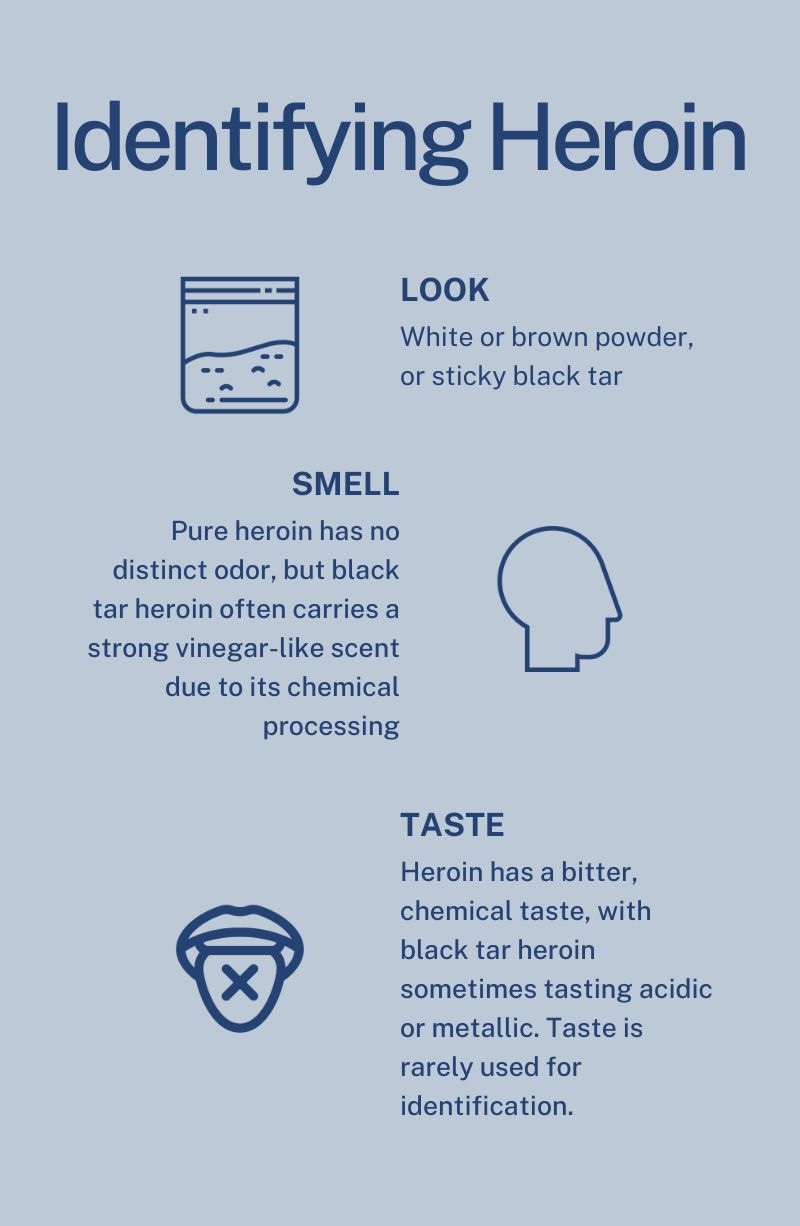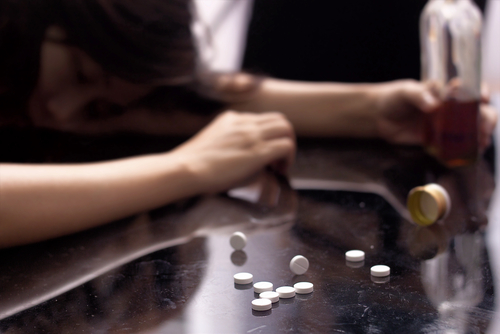Recognizing what heroin looks like is a crucial step in identifying its use and seeking help for addiction. At Pathways Recovery Center, we prioritize educating individuals and families about the appearance and dangers of heroin, a highly addictive opioid with severe health risks. Understanding its various forms can help prevent accidental exposure and support early intervention.
Heroin commonly appears in three distinct forms:
- White Powder Heroin – A fine, white or off-white powder, often the most potent and frequently cut with substances like sugar, starch, or fentanyl.
- Brown Powder Heroin – A coarse, brownish powder with varying shades, typically less refined and easier to mix with other substances.
- Black Tar Heroin – A sticky, dark, tar-like substance that is less pure and often has a strong vinegar-like odor due to its production process.
The appearance of heroin varies depending on its composition, additives, and purity. While pure heroin is odorless, black tar heroin emits a distinct smell due to acetic acid used in its production. Its bitter taste can also change based on cutting agents.
Heroin is frequently laced with dangerous substances, including fentanyl, which significantly increases overdose risk. According to the National Institute on Drug Abuse (NIDA), heroin use affected approximately 0.3% of the U.S. population, contributing to over 14,000 overdose deaths in 2019 alone. These alarming statistics highlight the urgent need for awareness and intervention.
By understanding what heroin looks like, smells like, and how it is cut, individuals and families can take the first step toward identifying use and seeking treatment. At Pathways Recovery Center, we provide expert support, education, and comprehensive addiction treatment to help individuals break free from heroin dependence. If you or a loved one is struggling, reach out today for professional help and guidance.

What Does Heroin Look Like
Understanding what heroin looks like is crucial for early detection and intervention. The drug’s appearance, texture, and additives can vary significantly, affecting its potency and danger levels. Identifying heroin correctly can help prevent unintentional exposure, misuse, and overdose.
Forms of Heroin and Their Characteristics
Heroin typically appears in three distinct forms: white powder, brown powder, and black tar heroin. Each form differs in purity, texture, and risks due to the way it is processed and the substances used to dilute it.
White Powder Heroin
White powder heroin is the most refined and typically the most potent. It usually appears as a fine, white, or off-white powder, but its color can range from beige to light brown depending on additives and impurities. Due to its high purity, it is often mixed with substances such as sugar, starch, quinine, and caffeine. More dangerously, it is frequently cut with fentanyl, a synthetic opioid that drastically increases the risk of overdose.
According to the 2020 National Drug Threat Assessment, white powder heroin is most commonly found in the Great Lakes, Midwest, and Northeast regions of the U.S. It is often snorted, smoked, or dissolved for injection.
Brown Powder Heroin
Less refined than white powder heroin, brown heroin has a coarser, gritty texture and varies in color from light brown to dark brown. This form results from a less sophisticated processing method, leaving behind more impurities. While still potent, brown heroin is typically harder to dissolve, requiring the addition of an acidic solution to prepare it for injection.
Because of its appearance, brown heroin is easier to disguise and can sometimes be mistaken for other powdered substances. This makes it riskier for accidental ingestion and harder to detect in certain environments.
Black Tar Heroin
Unlike powder forms, black tar heroin has a sticky, tar-like consistency and is dark brown or black in color. Its thick, gooey texture comes from the incomplete acetylation process used in its production. While it is less pure than white or brown heroin, it is still highly addictive and carries significant health risks.
Black tar heroin is predominantly found in the Western United States, especially in states like California and Arizona. It is often injected after being dissolved, but its thick texture increases the risk of infections, abscesses, and vein damage. A distinct characteristic of black tar heroin is its strong vinegar-like smell, caused by the acetic acid used during manufacturing.
Taste and Smell of Heroin
Heroin’s taste and odor can vary depending on its purity and additives. Pure heroin is typically odorless, making it difficult to detect by smell alone. However, black tar heroin often emits a noticeable vinegar-like scent due to the chemicals used in its production. Additionally, purple heroin, a dangerous variant often laced with fentanyl or other synthetic opioids, may have slight chemical or acidic odors depending on the substances mixed with it.
The taste of heroin is generally bitter and chemical-like. While white and brown heroin retain this bitterness, black tar heroin may have a more acidic or metallic taste. Since heroin is usually injected, snorted, or smoked rather than consumed orally, taste is rarely used as a primary identification method.
Why Identifying Heroin is Crucial
The widespread availability of heroin and the increasing presence of fentanyl make early identification more important than ever. Heroin-related overdoses remain a major public health crisis. According to the National Institute on Drug Abuse (NIDA), nearly 9,173 overdose deaths in 2021 were linked to heroin use.
At Pathways Recovery Center, we emphasize education as a vital step in combating heroin addiction. By understanding what heroin looks like and how it is used, individuals and families can take proactive steps to prevent drug-related harm. If you or a loved one is struggling with heroin use, professional treatment is the most effective path to recovery. Contact us today to learn about safe, evidence-based treatment options and start the journey toward a healthier future.
Heroin Withdrawal Symptoms & Signs
Withdrawal from heroin can be intensely uncomfortable and a significant barrier to overcoming addiction. Recognizing the symptoms and signs of heroin withdrawal is crucial for those seeking to understand and support individuals in the recovery process. Symptoms can range from mild to severe and typically include:
- Severe cravings for the drug
- Nausea and vomiting
- Sweating and cold flashes
- Agitation and irritability
- Muscle aches and pains
- Severe mood swings
These symptoms can begin within a few hours of the last drug use and are a clear signal that the body is adjusting to the absence of the drug. At Pathways Recovery Center, our detox programs are designed to help manage these symptoms in a safe environment, providing medical support and supervision to ease the withdrawal process.
Understanding the classification of heroin is essential for grasping its effects on the body. Heroin is not a stimulant but an opioid, which means it is a depressant that acts on the opioid receptors in the brain. Heroin works by creating a surge of pleasurable sensations, often described as a rush, followed by a state of sedation and decreased awareness of pain and emotional distress. This mechanism can make it highly addictive, as users seek to recreate these feelings, often leading to physical dependence and addiction.
Heroin Addiction Treatment at Pathways Recovery Center
Heroin addiction is a complex condition that requires comprehensive treatment strategies, including detoxification, therapy, and ongoing support. At Pathways Recovery Center, we provide a nurturing environment where individuals can embark on their journey to recovery with the help of a multidisciplinary team of addiction specialists. Our approach is holistic and tailored to each individual’s unique needs.
If you or someone you love is struggling with heroin addiction, it’s important to seek professional help. Understanding what heroin looks like, tastes, and smells like is just the first step toward recognizing its presence and impact. With the right support and treatment, recovery is possible. We are here to provide the care and support needed every step of the way.




